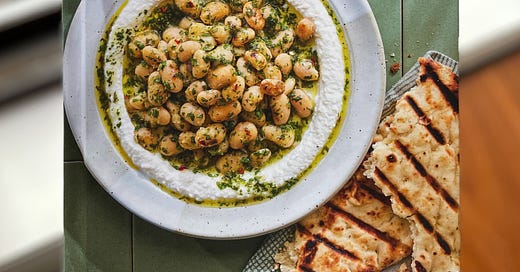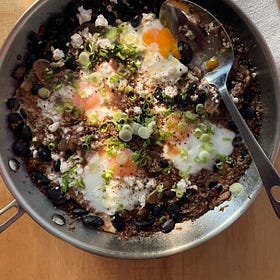Honoring the Pantry with Erin Alderson
An exciting new vegetarian cookbook brings the pantry to life — and will have you looking at your grains, legumes, and nuts & seeds in brand new ways
Erin Alderson of Naturally Ella always comes top of mind when I think of California home cooking. Centering seasonal vegetables in sexy ways, using a global roster of ingredients, and honing a flexible style she calls “component cooking,” I’m always so inspired and hungry when I check out what she’s doing.
(And beyond her beautiful recipes, I also feel a kinship with Erin because a few years ago I learned that she’s a fellow former marching band drum major!)
Erin periodically offers peeks into her overflowing garden, and in her day to day posting she shares how she makes the absolute most of it. Beyond the produce on the plate, she stocks up her spice cabinet with seeds and dried herbs from the garden, makes her own ferments, mills her own flours (sifting them for her baking and porridges), and even sources natural dyes from her garden for clothing and linens.
Knowing this about her, I’ve been excited to see how she approaches pantry cooking in her new cookbook The Yearlong Pantry. Pantry cooking is a category that’s often presented as quick, easy, and on-the-fly. It conjures things like shelf-stable, everyday, basics — foods you can take for granted because they’re there when you need them. Not fleeting and precious like, say, fava beans and strawberries are.
And while all this does apply to her book — it’s organized by grains, legumes, and nuts and seeds — she frames these core pantry ingredients as plants, ingredients that start as seeds and are very much alive, just as connected to the produce world as a juicy summer tomato is.

Then she unleashes the full potential of each ingredient in the kitchen. For example her primer on grains includes tips on cracking them (she makes a case, as you’ll see below, that a flour mill might be an appliance worth investing in), as well as smoking, popping, and frying them, too. This is all before you even get to the wonderful recipes. The book is just jam packed with information.
Knowing that many of you are bean people, and that you probably have a lot of respect for these pantry staples, too, I really think you’ll enjoy The Yearlong Pantry. Erin kindly answered a couple questions below, as well as shared the recipe for her outrageously good pinto bean chili, which will be available for a week before it goes behind a paywall.
Scroll down for the Q&A, and be sure to check out Erin’s wonderful book, The Yearlong Pantry.
Recent recipes
Power Porridge
A twist on my usual approach to steel-cut oats and a variation on "proats" — it's more protein and fiber, without any protein powder.
A Pantry Friendly, Riffable Skillet Meal
A one-skillet meal with beans, quinoa, eggs, and a sprinkling of feta — comfort food for sure.
Tips for Your Tofu Scrambles
My approach to tofu scrambles is less about convincing anyone they're eggs, and more about celebrating the fact that they're tofu.
Q&A with Erin Alderson

In your work you really exult in the seasons, sharing the gems of your beautiful garden and the splendor that California has to offer — yet The Yearlong Pantry doesn't really take a produce-forward angle. How did you land on the building blocks of your Yearlong Pantry?
It’s true that I am definitely a seasonal eater and living in the central valley of California affords me a really easy time eating seasonally. However I found myself more and more interested in the ingredients that helped me to make the most of seasonal cooking. Which, as you see in the book, are grains, legumes, nuts, and seeds.
I found the more I cooked with a focus on these ingredients, the easier time I had working with whatever produce was best in any given week (which is also super helpful when it’s my own garden and things are often sporadic)! These are the ingredients that are foundational for every meal.
Do I really need to get a flour mill? You've very nearly convinced me that I should.
Ha! I would definitely be the first to admit that having a flour mill is not for everyone but I think there’s a few key things that, if a person does enjoy, is worth it. For starters, most commercial whole wheat flour is actually not 100% whole wheat. It’s gone through an extraction process. Which, for most people, isn’t a big deal. However, if you’re really wanting to incorporate whole grains and flours into your diet, it can be a bit of a bummer.
I also think it’s a machine that’s a lot more versatile than people give it credit for. In my book I talk a bit about my use of cracked grains in various sizes for making things like whole grain risottos, porridges, and polenta-type meals. If you have a mill that allows for adjusting grind coarseness, you can effectively crack your grains to any coarseness and really play with textures within a meal.
Finally, I love the ability to buy whole grains and then process as needed. Whole grains store better for longer and this gives me a bit more control over how many ways I can use these ingredients (anything from whole through cracked and to flour). I like having this control and not having to keep many different variations of one ingredient!
So many everyday or family cookbooks seem to be about shortcuts and hacks, and operate from the assumption that there is no time to cook and little enjoyment to be had in it. I don't know if you'd put your book in such a category, but I'm struck by its first sentence, stating that you live in a household of neurodivergent humans, with your husband and son, and that this really shapes your cooking. And in this and other ways, The Yearlong Pantry feels like kind of an antidote to that prevailing style of everyday, family-oriented cookbook. Is this something you thought about at all as you were working on it?
This is SO interesting and I can’t help but laugh a bit because my cooking style is definitely far away from hacks and lack of enjoyment. Which I get the hacks — time is a thing! — however, at the core of my cooking, I want to be able to take a bit of what I make and really be able to enjoy it. I grew up having such a contentious relationship with food and when it’s something you need three times a day, it can cause so much grief. I knew, once having a child, that I didn’t want that for them.
And so, beyond just cooking for myself, I also like to a keep a level of fluidity so that I can adapt to the preferences of my family. My hope is the book can help others do that as well, just by getting to know these ingredients a little more.
The Yearlong Pantry is sprinkled with global ingredients and nods to other cooks and books — where do you find inspiration, and what have been your key influences over the years?
Whew, everywhere! We live in such a unique time because we can travel the world without ever leaving our home. The amount of writing and media around food is astonishing! The caliber of cookbooks coming out now is unmatched and I swear every week I pick up a new one and am able to learn about something I didn’t know before (and this has been happening for 20 years of my life)!
And I feel like it’s easy for people to dismiss TikTok because of just the sheer amount of content, both good and bad, but the barrier to sharing is so much lower which can be a really great thing for food. I’m constantly inspired by people sharing meals from around the world on TikTok.
My motto has always been to never stop learning which makes being inspired so much easier!
If it had to be just one, what's one underrated ingredient that should be in every cook's pantry?
ONE!?!? This is a tough question! I can make a case for each ingredient in the book to be the one. But since you asked, I’m going to go with walnuts because I feel like so often they are overlooked for other nuts (or only picked up for sweet things). They make a great snack but can easily be turned into a rich nut butter, milk, or nut cream. They have a solid, earthy flavor without being overpowering.
For more information, check out Erin’s book, website, and Instagram.








Sounds like a fantastic book.
Lovely interview - am a big fan of Erin's recipes and her approach to cooking and love that she called out walnuts at the end of the interview. I agree they are so underrated and walnut butter is one of my favourite nut butters - it is so delicious on toasted sourdough bread with a sprinkle of sea salt and a drizzle of honey.